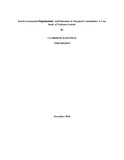| dc.description.abstract | Child access to education in Kenya has been a major challenge primarily due to cost of schooling. In response, the government of Kenya initiated free primary education in 2003 to ensure that all children access primary education regardless of their socio-economic backgrounds. School participation for example, is higher in central province than in North-eastern province and in spite of this initiative by the government, marginal areas continue to experience low access to primary schooling. High levels of poverty among the household and attendant disrupted livelihoods are factors accounting for this. The government and NGOs have been present in these areas implementing interventions to promote access to education but transition levels in schools continue to characterize access to education in these areas.
The overall research objective of this study was to assess the role of NGOs in addressing low transition levels in NGOs supported schools. The study focused on education in Turkana- Central, in Turkana County. The data for this study was based on a survey of thirty households with children sponsored by Non- Governmental Organizations (NGOs). Interviews were conducted with primary school head teachers, NGOs program officers and Turkana-County government officials as key informants of the study.
The key findings showed that household income and parents’ education influenced transition levels in schools. The attendances in schools were fairly low and most of those enrolled failed to attend school regularly mainly due to lack of school fees. It was further observed that NGOs interventions have contributed to improving transition levels in schools. However, these interventions are inadequate and not sustainable to improve child education in the long run. The longevity of these interventions is not guaranteed, this is because the NGOs initiate programs that are not long-term. The study concluded that to improve effectiveness of child access to education in marginal communities especially Turkana-Central, the Government and key stakeholders, especially the NGOs need to look for ways of increasing sensitization on education at the local level and ensure that education is given first priority in budgetary allocation at the county level. | en_US |



